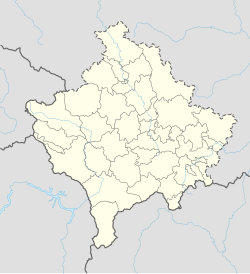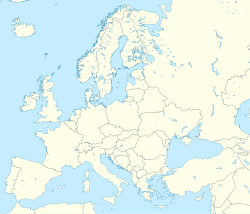Suva Reka
Suva Reka
| |
|---|---|
Town and municipality | |
From the top, View of Suva Reka, Xhamia e Qytetit, Suva Reka Bus station | |
| Coordinates: 42°22′48″N 20°49′19″E / 42.38000°N 20.82194°E | |
| Location | Kosovo |
| District | Prizren |
| Government | |
| • Mayor | Bali Muharremaj (AAK) |
| • Municipal | 361 km2 (139 sq mi) |
| Elevation | 389 m (1,276 ft) |
| Population (2011) | |
| • Urban | 10,422 |
| • Municipal | 59,722 |
| • Municipal density | 170/km2 (430/sq mi) |
| Time zone | UTC+1 (CET) |
| • Summer (DST) | UTC+2 (CEST) |
| Postal code | 23000 |
| Area code | +383 29 |
| Car plates | 04 |
| Climate | Cfb |
| Website | kk |
Suva Reka (Serbian Cyrillic: Сува Река) or Suhareka (Albanian – also known as Suharekë and Therandë) is a town and municipality located in the Prizren district of central-southern Kosovo. According to the 2011 census, the town has 10,422 inhabitants, while the municipality has 59,722 inhabitants.
Suva Reka is located 18 km (11 mi) from the city of Prizren, and 57 km (35 mi) from Kosovo's capital, Pristina.
Name
Suva Reka means "dry river" in Serbian. The Albanian spellings are Suharekë[1] or Suhareka (derived from the Slavic form), while an alternative[2] name was recently created by the Albanological Institute,[3] Therandë,[4] adopted from an unlocated ancient site (possibly in Suhareka or Lubizhda in the Mirusha valley[5]).[6]
History
Historical background
The municipality includes several medieval Serbian sites and old settlements, such as the villages of Banja, Suva Reka, Dulje, Mušutište, Popovljane, Rečane, Suva Reka, and churches of Virgin Hodegetria, St. George, Holy Trinity, St. Nicholas, among others. The settlement of Theranda itself was first mentioned in 1465.
Yugoslav period
From 1929 to 1941, Suva Reka was a town part of the Vardar Banovina of the Kingdom of Yugoslavia.
Between 1918 and 1941 the demographic structure of the municipality of Suva Reka has been affected by settlements and colonization such as the Serbian colonization and population settlement, for the most part from the Toplica District.[7]
On the night of 9–10 June 1984, ethnic Albanians desecrated 29 tombstones of the Church of the Holy Saviour.[8][9]
Kosovo War and aftermath
During the Kosovo War (1998–99), the Yugoslav army operated in the region and it was reported that it had killed and wounded many Albanian civilians. According to the Suva Reka office of the Council for the Defense of Human Rights and Freedoms, 430 people were killed in the municipality and 67 people were missing as of late August 1999.
The Suva Reka massacre conducted on 26 March 1999 committed by Serbian police officers resulted in 48 victims, fourteen of which were under 15 years old. 46 members of the victims were part of the Berisha family who were targeted because they had rented one of their homes to the OSCE observers in Suva Reka, who provided a sense of security to the local Albanians but withdrew from the area when NATO bombing began.[citation needed] After the slight withdrawal of the OSCE, incidences[spelling?] of abuse increased around late March, specifically with the beating and the harassment of ethnic Albanians residents by the Serbian police. Consequently, tensions soon increased after at least seven ethnic Albanians were killed by police or disappeared in unclear circumstances.
According to the OSCE, killings of smaller numbers of people also took place in the following villages: Bukos (Bukosh), Budakovo (Budakove), Vranic (Vraniq), Geljance (Gelanc), Sopina (Sopine), Mus-utiste (Mushtishte), and Lesane (Leshane).
After the war, Serbian heritage was destroyed all over Kosovo. The churches (including cemeteries) of Virgin Hodegetria, St. George, Holy Trinity, St. Nicholas and others were completely destroyed in 1999 after the arrival of KFOR and the end of the war.[10]
NATO set up a military base in the municipality, Camp Casablanca.
Culture
Churches
|
Mosques
|
Demographics
| Year | Pop. | ±% p.a. |
|---|---|---|
| 1948 | 27,044 | — |
| 1953 | 30,184 | +2.22% |
| 1961 | 34,729 | +1.77% |
| 1971 | 45,316 | +2.70% |
| 1981 | 59,434 | +2.75% |
| 1991 | 72,229 | +1.97% |
| 2011 | 59,722 | −0.95% |
| 2016 est. | 59,681 | −0.01% |
| Source: Division of Kosovo | ||
According to the 2011 census done by the Government of Kosovo, the municipality of Suva Reka had 59,722 inhabitants of which 98.9% were Kosovo Albanians.[11] According to OSCE, the whereabouts of the displaced Serb and Roma communities is unknown.[11]
Twin towns – Sister cities
Suva Reka is twinned with:
References
- ^ "Suhareke". kk.rks-gov.net. Retrieved 12 April 2018.
- ^ Robert Elsie (15 November 2010). Historical Dictionary of Kosovo. Scarecrow Press. pp. 298–. ISBN 978-0-8108-7483-1.
- ^ Saskia Drude (2008). Hundert Wochen Kosovo: Alltag in einem unfertigen Land. Karin Fischer Verlag. pp. 99–. ISBN 978-3-89514-836-1.
- ^ Elsie,R. (2010-11-15). Historical Dictionary of Kosovo. Scarecrow Press. p. 268. ISBN 9780810874831.
- ^ Arheološko blago Kosova i Metohije: Text. Srpska Akademija nauka i umetnosti. 1998. p. 286.
- ^ Andreas Wittkowsky (2011). Grand Hotel Kosovo: Schlaglichter einer europäischen Staatsbildung (in German). LIT Verlag Münster. pp. 69–. ISBN 978-3-643-11425-9.
- ^ "Kolonizimi serb i Kosovës" (in Albanian). 9 Jan 2011. Archived from the original on 2011-01-09..
- ^ "Вапаји Са Метохије И Косова". Православље (in Serbian) (429). 1 February 1985. Archived from the original on 2011-11-27. Retrieved 28 July 2023.
- ^ Antonije Isaković (1990). "Kosovsko-metohijski zbornik". SANU: 84.
{{cite journal}}: Cite journal requires|journal=(help) - ^ "Destroyed and Damaged Cultural Properties in Kosovo and Metohija 1994-2004" (PDF). Municipality of Dečani. Retrieved 2023-08-17.
- ^ a b "MUNICIPAL PROFILE 2018 - PRIZREN REGION - SUHAREKË/SUVA REKA". Retrieved 2023-08-17.
- ^ "Komuna Suhareke - Suhareka & Fellbach". kk.rks-gov.net. Retrieved 2017-01-31.
- ^ "Lilburn Becomes a 'Sister City' With Kosovo Town". patch.com. 16 July 2013. Retrieved 12 April 2018.








